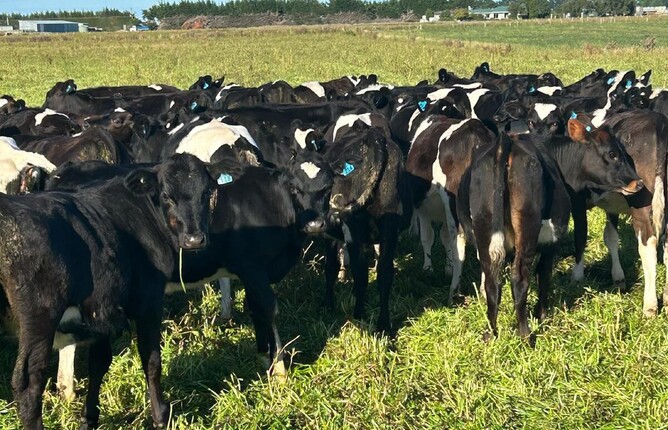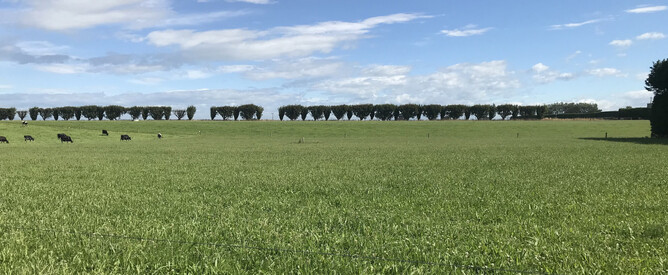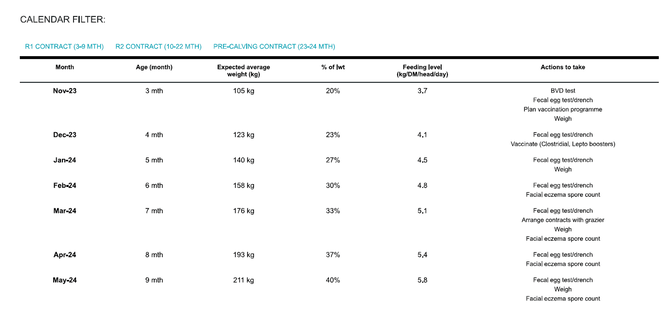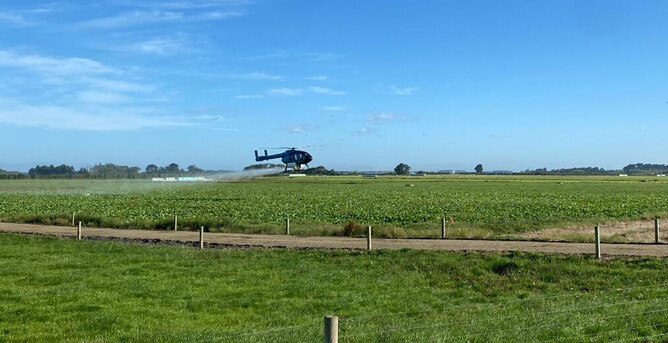Andrea Dixon – General Manager, Southern Dairy Hub
The weather has certainly provided challenges with managing grass quality and finding the weather windows to cut surplus feed.
Like many farmers we have made more baleage than normal this summer, which has set us up well for ending out the season and for the winter. We will use this surplus in the coming weeks before it gets too wet and reduce the feed going through the shed. This winter we will be looking to see how we can improve the profitability of fodder beet winter grazing while maintaining the environmental footprint we achieved in the kale and fodder beet system comparison. We will also be examining the grass baleage winter system to find the sweet spot where we can minimise the area used for wintering but not have to fully regrass every paddock. We will be looking at bale density, area allocation, allocation frequency, cow comfort and health, labour and environmental footprint. Soil mineral nitrogen will be used to give an indication of nitrate loss risk from this wintering system.
The cows are holding production pretty well and we’re 5% up on production year-to-date. We're milking more cows this year than at the same time last year, so we'll bank as much milk as we can without compromising our dry off plan.
We're beginning to look at upgrade options for our calf shed, and we’ve leaned on nearby farmers to ensure we get this right. I look forward to sharing the upgrades with you once they have been confirmed.
Recent studies have reaffirmed the importance of hands-on demonstrations in farming, which is why we're thrilled to announce another field day scheduled for 12 March, featuring Andy Macfarlane from Fonterra and ANZCO as our special guest. Be sure to mark your calendars for this event — you won't want to miss it.
For further updates on our ongoing work in research and innovation, please keep an eye on our Facebook feed and website. And if you're keen to have a look through the farm then please don’t hesitate to contact me.
This newsletter is packed with useful information and insights – please share it with friends who might find it interesting.
What’s been happening
Infrastructure Project Update
The plan to build a new wintering infrastructure at the Southern Dairy Hub hasn’t received funding support to progress at this time.
The design of a fully covered structure to trial different wintering surfaces was modified from the original concept based on feedback from southern farmers. These design changes, coupled with increases in construction costs, resulted in the infrastructure build cost exceeding the funding allocated by the Ministry for Primary Industries and DairyNZ in 2021.
Research undertaken throughout the project has contributed to DairyNZ's deeper understanding of the performance and practicality of different wintering surface options. It has also provided valuable insights into best practice wintering infrastructure design and construction processes. DairyNZ is currently preparing a summary of these learnings, which will highlight key considerations for constructing different wintering surface and infrastructure options.
DairyNZ researchers continue to work with the Hub and project funders to explore opportunities for ongoing wintering research, building upon the knowledge gained from research to date.
Getting more than you expect at the Waimumu Field Days
I went to the Waimumu Field Days to share what we are doing on our research farm; what I did not expect was to come away feeling so inspired, and with such fascinating insights into what farmers are thinking about the future.
We had an opportunity to have a stand alongside DairyNZ (thanks, DairyNZ!). For all that people know about the Hub, I often hear that they may not see the value they get from having a research farm on their doorstep and aren’t sure how to translate the research into practical on-farm activity.
Over the course of three days, I must have spoken to about 100 people, and the beauty of events like these is that you get to interact with people and get a real sense of what is occupying their minds most right now. The in-depth conversations with farmers and rural professionals really inspired me.
I thought I would be telling people about the value they get from the Hub, and I did, but we mainly debated what future challenges are coming our way, the things they see as important in the next ten years, how they want to embrace technology and what the many barriers are.
There were four main themes that I took away:
Firstly, technology is complex and seems to be getting more so. What do farmers and rural professionals use - when, how and on what platforms? How do they get staff to embrace new technology, especially if there is minimal training offered? There was a real desire for dashboards to provide better insights to help make decisions on farm.
Secondly, and no surprises there, compliance is complex. The farmers I spoke to were questioning what decisions they needed to make today to set them up for positive future compliance.
Thirdly, farmers talked about the value of demonstration and learning from showcasing in real time. Not when multi-year research is finished; they want research, new practices, insights and technology visible and easy to access, in real time and ideally through on-farm demonstration.
I also talked to many farmers about the change in how they approach farming. They talked about balancing sustainability, profitability, and a home life. I reflected after several conversations along these lines, that it’s the way of the future – farming with low inputs and outputs to create the sweet spot so farmers can be profitable but also – and most importantly – have a life away from the farm.
For me, the ultimate value-add of the Field Days was including the whole farm team. I saw so many farm teams having a great time together. They were engaging with the sector and their community, seeing what was available and new. For our farm team, being present at the event gave everyone such a buzz. We all appreciated being involved, and it was a rewarding and hugely engaging experience for everyone.
I left the Field Days feeling reinvigorated, and the people I spoke to helped me get clarity on the purpose of the Hub and how we can share more insights with our community. It highlighted the importance of demonstration, so watch this space! There's more coming your way soon.
It also reinforced to me that we need to constantly support our next generation into farming. Top of my to-do list is engaging with schools and universities to open the doors of Southern Dairy Hub, so students can learn firsthand, through demonstration, the incredible things happening on their doorstep.
AgResearch study shines light on farmer preference for digestible information from people who have built trust with farmers
A recent AgResearch study explored how research farms can better support sustainable farming through their communications to farmers, and used Southern Dairy Hub as their case study. The study found that involving farmers throughout the research process can build credibility and trust, and that farmers preferred easily digestible, practical information to facilitate learning and adoption.
Findings indicated that early adopters play a crucial role in demonstrating the value of SDH research and that there is an opportunity to conduct more demonstrations and smaller research projects to engage farmers throughout long-term research projects.
We'll be taking the feedback and findings from the study and applying to our communications at the Hub, so watch this space!
We’d love to see you at our Field Day
Our upcoming Field Day on 12 March promises to be a good one! Join us from 10am to 1.30pm, as we delve into the intricacies of interpreting market signals and navigating the future of greenhouse gas emissions.
DairyNZ will lead discussions on the benefits of plantain as a cost-effective N-mitigation tool, providing insights into different plantain cultivars. Learn about the latest research findings on N losses, as well as the establishment and maintenance of plantain in farm systems. Plus, we’ll explore the impact of greenhouse gases and the significance of soil carbon.
We’re thrilled to welcome special guest Andy Macfarlane, Director of ANZCO and Fonterra, who will share insights on integrating science and education into business strategies. Andy – a strategic thinker with a passion for food production and sustainability – has held various leadership roles, including chairing the NZ Institute of Primary Industry Management and Deer Industry NZ. He has served on the boards of AgResearch and Ngāi Tahu Farming, and co-founded Macfarlane Rural Business Ltd.
With wife Tricia, Andy farms irrigated land in Mid Canterbury, primarily focused on dairy. Their son and his family specialise in deer and beef in South Canterbury. Both farms are known for balancing high productivity with positive environmental outcomes.
Don't miss out on this incredibly informative event! Lunch will be generously sponsored by PGG Wrightson. For more information, visit: www.southerndairyhub.co.nz/events
Plantain trials at SDH Field Day
Farmers joining us at the upcoming Field Day on 12 March (see previous article) will also get a chance to hear Sustainable Food and Fibre Futures Plantain Programme lead Kate Fransen share the latest programme results.
Evidence is building for the benefits of plantain for reducing nitrate leaching. Recent studies at Massey University have demonstrated a notable decrease in nitrate leaching ranging from 20-50% with the incorporation of Ecotain plantain into the sward, on heavy soils. Similarly, at Lincoln under irrigation, pastures containing 15-30% Ecotain plantain have achieved approximately a 20% reduction in nitrate leaching. New research also highlights plantain's potential as an effective tool in mitigating nitrous oxide emissions.
During the Field Day, local farmer Tim McRae and Canterbury farmer Andy Macfarlane will offer insights into their experiences with integrating plantain into their farm systems. Attendees will have the unique opportunity to observe the progress of plantain cultivation at the SDH farm firsthand. Discussions will also address greenhouse gases and soil carbon, exploring the feasibility of achieving carbon neutrality.
Farmers will get to explore the comprehensive range of plantain cultivars showcased in one of the programme's plantain cultivar evaluation system trials, and gain valuable insights into their respective potential for reducing nitrate leaching and nitrous oxide emissions.
Don't miss out on this event! For more information, follow us on Facebook or visit our website: www.southerndairyhub.co.nz/events
Importance of achieving heifer liveweight targets
Heifer liveweights are important to the dairy industry. A 2014 study [1] revealed that heifers across New Zealand typically reached only 91% of their target liveweight, with 79% falling below target at calving. This shortfall significantly impacts herd reproductive performance, with 26% of heifers exiting the herd after just one lactation. This highlights the importance of heifers reaching target liveweights prior to entering the dairy herd.
In 2019, another study indicated that for every 1% a heifer fell below target liveweight at calving, it cost approximately 2kg milksolids (MS) per year. In Southland, recent data from LIC for 2021-born heifers showed an average shortfall of 3% below their 22-month target, potentially resulting in a lost milk production of 6 kgMS per heifer for the region.
While Southland's herds perform better than the industry average of 5-6% below target, the -13% "winter dip" in Southland compared to 8-9% nationally remains concerning, with this trend continuing into the 2022 cohort.
[1] Heifer Management: The impact of undergrown heifers by L McNaughton, T Brownlee and S McDougall
Further research indicates that the greater the difference in a heifer's weight at 12 and 21 months of age, the more significant the negative impact on lifetime production. Simply catching up poorly grown animals later does not rectify the situation. Ensuring heifers attain target liveweights is crucial for future milk production.
“Heifers that were a greater proportion of their 21-month LWT at 12 months of age produced more first lactation and cumulative 3-year milk yields than heifers that were a lesser proportion of their 21-month LWT at 12 months of age. These results indicate that increased growth in early life of New Zealand dairy heifers is beneficial to future milk production.” [2]
[2] RC Handcock ORCID Icon, N Lopez-VillalobosORCID Icon, LR McNaughton, PJ Back, GR EdwardsORCID Icon &RE HicksonORCID Icon.
Failing to meet heifer liveweight targets incurs significant costs for the region. The Southern Dairy Hub closely monitors this as the 2023-born animals head off to grazing. Utilising the DairyNZ Heifer Development Planning [3] tool for drafting grazing contracts and working with graziers, we calculated average target liveweights and identified the need for animals to grow at an average of 0.7kg per day to reach targets.
The tool provides a monthly calendar of expected target average weights, required feeding levels, and suggested actions, enhancing our ability to manage young stock growth effectively.
We've also engaged the VetSouth "Weigh it Up" team to weigh heifers monthly (excluding June and July), administer health treatments, and upload weight and health data into Minda. This approach ensures regular weighing with accurate scales and timely health treatments, optimising the 2023 cohort's chances of reaching milestone liveweight targets.
In an earlier newsletter [4] we showcased the Hub’s focus on monitoring the Body Condition Score of first and second-calvers from calving to mating, alongside utilising priority feeding strategies. This focus has remained consistent through the dry-off period, aiming to maximise lactation days and ensure optimal animal condition. This is particularly crucial given that cows don't reach their full mature liveweight until the end of their third lactation, which impacts feed intake and potentially production. I look forward to sharing with you the progress with this group of animals.
[3] Heifer Development Plan - DairyNZ | DairyNZ
[4] Southern Dairy Hub newsletter October 2024
Fodder beet research highlights the importance of understanding feed nutritional content
DairyNZ scientists recently published results from a nutritional analysis of 694 fodder beet (FB) samples sourced from monitor farms, research projects and cultivar evaluation trials across New Zealand, including research conducted at the Southern Dairy Hub.
Fodder beet's unique combination of high soluble sugar and low crude protein content presents both environmental benefits and nutritional challenges, making it a unique crop in New Zealand dairy systems.
The data revealed significant variability in the nutritional composition of fodder beet leaf and bulb across different regions and cultivars.
These findings highlight that fodder beet bulbs, which typically make up 70-90% of the crop dry matter, tend to be deficient in crude protein, fibre, phosphorus, calcium and sulphur, while rich in soluble sugars. Hence, careful monitoring of these nutrients is needed when incorporating fodder beet into cattle diets. The choice of supplementary feed or pasture offered with FB is also important.
The observed variation emphasises the importance of farmers testing their fodder beet crops and supplementary feeds to confirm their nutritional status and ensure adequate nutrient intake for their cows. DairyNZ’s Feed Checker Calculator is a useful resource to help calculate nutrient requirements relative to diets on offer – for access, search ‘Feed Checker’ online at www.dairynz.co.nz
The full Fodder Beet research paper is available to read at www.southerndairyhub.co.nz/cumulative-effects-of-fodder-beet

